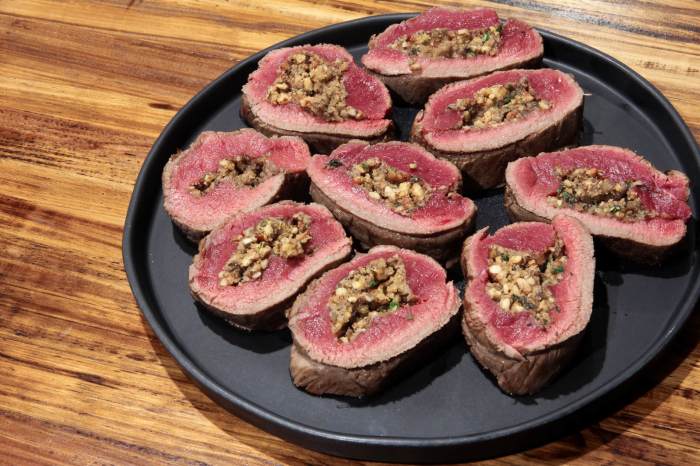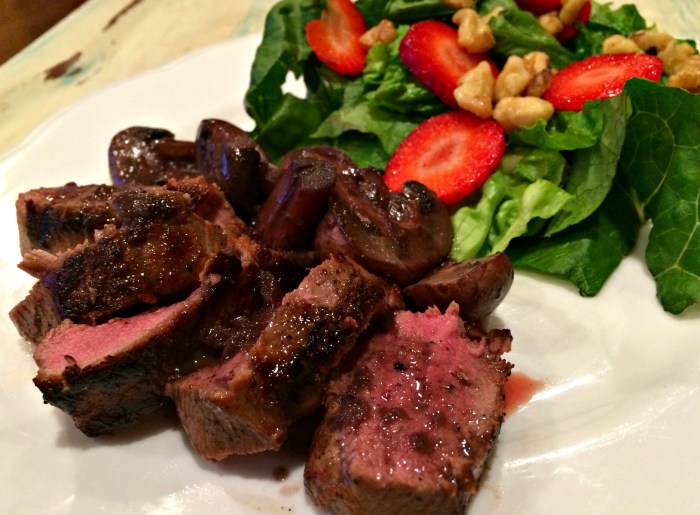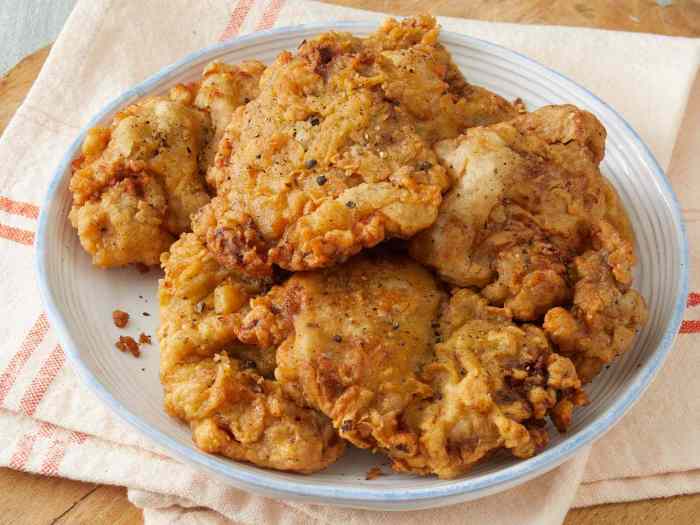Venison backstrap recipes offer a unique culinary journey, showcasing the rich flavor and versatility of this prized cut of meat. Venison backstrap, often considered the “filet mignon” of the deer, boasts a delicate texture and a distinct, slightly gamey flavor that’s both enticing and satisfying.
From classic grilling techniques to innovative braising methods, the possibilities for preparing this culinary treasure are endless.
This guide delves into the world of venison backstrap, exploring its characteristics, preparation techniques, and diverse cooking methods. We’ll provide a collection of recipes that cater to various tastes and preferences, offering a culinary adventure that’s both delicious and informative.
Venison Backstrap
Venison backstrap, a prized cut of meat from the deer, is a culinary treasure celebrated for its delicate flavor, tender texture, and remarkable versatility. It’s a lean, flavorful, and healthy alternative to traditional red meats, offering a unique taste experience and a wealth of nutritional benefits.
Nutritional Benefits of Venison Backstrap
Venison backstrap is a lean protein source, low in fat and calories, making it a healthy choice for those seeking to maintain a balanced diet. Compared to beef, pork, and chicken, venison backstrap contains significantly less saturated fat and cholesterol.
It’s also a rich source of essential nutrients, including iron, zinc, and B vitamins.
- Lower in Fat and Calories:Venison backstrap is naturally lean, containing significantly less fat and calories compared to other popular meats. This makes it an ideal choice for those following a healthy diet or watching their weight. For example, a 3-ounce serving of venison backstrap contains about 120 calories and 3 grams of fat, compared to 200 calories and 10 grams of fat in a similar serving of beef.
- High in Protein:Venison backstrap is an excellent source of protein, providing essential amino acids that support muscle growth, repair, and overall health. A 3-ounce serving of venison backstrap contains approximately 20 grams of protein, making it a valuable addition to any balanced diet.
- Rich in Iron:Venison backstrap is a good source of iron, a vital mineral that plays a crucial role in red blood cell production and oxygen transport throughout the body. Iron deficiency can lead to fatigue, weakness, and other health problems. Consuming venison backstrap can help meet your daily iron needs.
- Packed with B Vitamins:Venison backstrap is a good source of B vitamins, including niacin, riboflavin, and vitamin B12. These vitamins play a crucial role in energy metabolism, cell growth, and nervous system function. Including venison backstrap in your diet can contribute to overall well-being.
Cultural Significance of Venison Backstrap
Venison backstrap holds cultural significance in various regions around the world, representing a traditional food source and a symbol of hunting heritage. In many cultures, venison backstrap is a prized delicacy, often reserved for special occasions and celebrations.
- Native American Traditions:For centuries, Native American tribes have relied on deer hunting for sustenance and survival. Venison backstrap was a staple food source, often prepared in various ways, including roasting, grilling, and drying. It held a significant place in their cultural practices and traditions.
You also will receive the benefits of visiting shirley temple drink recipe today.
- European Hunting Culture:Venison backstrap has a long history in European hunting culture, where it was considered a prized game meat. In many regions, venison backstrap was reserved for the aristocracy and nobility, reflecting its status as a delicacy. This tradition continues today, with venison backstrap being featured in fine dining establishments and gourmet recipes.
- Modern-Day Popularity:In recent years, venison backstrap has gained popularity worldwide, driven by growing interest in sustainable and healthy eating practices. Its unique flavor, tender texture, and nutritional benefits have made it a favorite among discerning foodies and health-conscious consumers.
Preparation Techniques for Venison Backstrap
Preparing venison backstrap involves several steps that ensure optimal tenderness and flavor. These techniques focus on trimming excess fat, marinating for enhanced taste, and tenderizing to create a more palatable texture.
Trimming Venison Backstrap
Trimming excess fat from the venison backstrap is crucial for achieving a leaner and more flavorful final product. Fat can render during cooking, potentially making the meat greasy. It’s essential to remove any visible fat, including the silverskin, a tough membrane that can make the meat chewy.
- Using a sharp knife, carefully trim away any excess fat from the venison backstrap. This includes trimming along the edges and removing any visible fat pockets.
- Identify and remove the silverskin, a thin, tough membrane that runs along the surface of the meat. This can be done by gently peeling it away with a knife or using a paper towel to grip it and pull it off.
- Once trimmed, the venison backstrap should have a uniform, lean appearance. The meat should be free of excess fat and the silverskin should be completely removed.
Marinating Venison Backstrap
Marinating venison backstrap is a great way to infuse the meat with flavor and help tenderize it. Marinades typically contain acidic ingredients like vinegar or citrus juice, which help break down the muscle fibers, as well as herbs, spices, and aromatics that add depth of flavor.
- Choose a marinade that complements the flavor profile of the venison. Common marinade ingredients include red wine, balsamic vinegar, soy sauce, garlic, onions, herbs like rosemary and thyme, and spices like black pepper and paprika.
- Place the trimmed venison backstrap in a sealable container or resealable bag and pour the marinade over it. Make sure the meat is completely submerged in the marinade.
- Refrigerate the marinated venison backstrap for at least 2-4 hours, or up to 24 hours for optimal flavor infusion and tenderization.
Tenderizing Venison Backstrap, Venison backstrap recipes
Tenderizing venison backstrap is essential because venison is naturally lean and can be tough if not properly prepared. There are several methods for tenderizing venison, including using a meat mallet, marinating with acidic ingredients, and slow cooking.
- Using a meat mallet: Pound the venison backstrap gently with a meat mallet to break down the muscle fibers and make it more tender. This technique is particularly effective for thicker cuts of meat.
- Marinating with acidic ingredients: Acidic ingredients, such as vinegar, citrus juice, or yogurt, can help break down the proteins in the venison, making it more tender. This process is often combined with other marinade ingredients for enhanced flavor.
- Slow cooking: Slow cooking venison backstrap at a low temperature for an extended period can help tenderize the meat. This method allows the heat to penetrate the meat slowly and evenly, breaking down the tough muscle fibers.
Storing and Handling Venison Backstrap
Proper storage and handling of venison backstrap are crucial for maintaining its quality and safety.
- Store venison backstrap in the refrigerator at a temperature of 40°F (4°C) or below. The meat should be wrapped tightly in plastic wrap or placed in a sealed container to prevent freezer burn.
- Venison backstrap can be frozen for up to 3-6 months. When freezing, wrap the meat tightly in plastic wrap and then place it in a freezer-safe bag to prevent freezer burn.
- Always wash your hands thoroughly with soap and water before and after handling raw venison. Also, clean all surfaces and utensils that come into contact with raw meat to prevent cross-contamination.
Preventing Venison Backstrap from Drying Out
Venison backstrap is naturally lean, making it prone to drying out during cooking. To prevent this, it’s essential to use appropriate cooking methods and monitor the internal temperature carefully.
- Cook venison backstrap to an internal temperature of 145°F (63°C) for medium-rare, or 160°F (71°C) for medium. Using a meat thermometer is the best way to ensure accurate cooking.
- Consider using moist-heat cooking methods, such as braising, roasting with liquid, or slow cooking. These methods help keep the meat moist and prevent it from drying out.
- Avoid overcooking venison backstrap, as this can make it tough and dry. Once the meat reaches the desired internal temperature, remove it from the heat source and let it rest for a few minutes before slicing and serving.
Venison Backstrap Cooking Methods

Venison backstrap, known for its lean and flavorful meat, offers a range of cooking methods that highlight its unique characteristics. Whether you prefer a quick sear or a slow braise, there’s a technique to suit your taste and occasion.
Cooking Methods
The most popular cooking methods for venison backstrap include grilling, pan-searing, roasting, and braising. Each method brings a distinct texture and flavor profile to the meat.
Grilling
Grilling is a popular method for venison backstrap, resulting in a flavorful and slightly smoky exterior. It’s ideal for achieving a crispy crust while keeping the interior tender and juicy.
Pan-Searing
Pan-searing is a quick and easy method that creates a flavorful crust on the backstrap. This method is perfect for smaller cuts or when you want a fast and delicious meal.
Roasting
Roasting is a versatile method that allows for even cooking and produces a tender and juicy backstrap. It’s a great option for larger cuts and when you want to cook a complete meal.
Braising
Braising is a slow and gentle cooking method that tenderizes tough cuts of meat. It involves searing the backstrap, then simmering it in a flavorful liquid until it’s fork-tender. This method is ideal for older venison or cuts with a tougher texture.
Comparing Cooking Methods
The choice of cooking method depends on the desired outcome, available time, and personal preferences. The following table compares and contrasts different methods based on time, temperature, and desired outcome.
| Cooking Method | Time | Temperature | Desired Outcome |
|---|---|---|---|
| Grilling | 10-15 minutes | Medium-high heat (400-450°F) | Crispy exterior, juicy interior, smoky flavor |
| Pan-Searing | 5-10 minutes | Medium-high heat (400-450°F) | Crispy crust, tender interior, quick cooking |
| Roasting | 30-45 minutes | 350-400°F | Tender and juicy, even cooking, flavorful |
| Braising | 1-2 hours | 300-325°F | Fork-tender, flavorful, moist |
Seasonings and Marinades
Seasonings and marinades play a crucial role in enhancing the flavor of venison backstrap. They can add depth, complexity, and balance to the meat.
Seasonings
Common seasonings for venison backstrap include salt, pepper, garlic powder, onion powder, paprika, and herbs like rosemary, thyme, and sage.
Marinades
Marinades can tenderize the meat and infuse it with flavor. Popular marinade ingredients include olive oil, vinegar, soy sauce, honey, citrus juice, and spices.
“A good marinade can transform venison backstrap from bland to flavorful, making it a delicious and satisfying meal.”
Venison Backstrap Recipes

Venison backstrap, a prized cut of meat, offers a unique flavor and texture that elevates any dish. From classic preparations to modern culinary twists, there’s a venison backstrap recipe for every palate and occasion. This section explores a diverse range of recipes, categorized by cooking method, cuisine, and desired level of difficulty, allowing you to embark on a culinary journey with this versatile ingredient.
Grilled Venison Backstrap
Grilled venison backstrap is a classic preparation that highlights the natural flavor of the meat. Here are some popular recipes:
- Grilled Venison Backstrap with Rosemary and Garlic: This recipe combines the earthy flavors of rosemary and garlic with the rich taste of venison. The backstrap is marinated in a mixture of olive oil, rosemary, garlic, salt, and pepper before being grilled to perfection. Serve with roasted vegetables or a creamy polenta for a complete meal.
- Grilled Venison Backstrap with Blackberry Sauce: This recipe adds a touch of sweetness and acidity to the savory venison. The backstrap is grilled and then topped with a blackberry sauce made with fresh blackberries, balsamic vinegar, and a touch of sugar. Serve with a side of mashed potatoes or wild rice for a satisfying meal.
Pan-Seared Venison Backstrap
Pan-searing is a quick and easy way to cook venison backstrap, resulting in a tender and flavorful dish.
- Pan-Seared Venison Backstrap with Wild Mushroom Sauce: This recipe combines the rich flavor of venison with the earthy aroma of wild mushrooms. The backstrap is pan-seared in butter and then topped with a creamy sauce made with wild mushrooms, shallots, and white wine. Serve with a side of roasted root vegetables for a hearty meal.
- Pan-Seared Venison Backstrap with Cranberry-Orange Glaze: This recipe offers a sweet and tangy twist on venison backstrap. The backstrap is pan-seared and then glazed with a mixture of cranberries, orange juice, and a touch of brown sugar. Serve with a side of roasted sweet potatoes or butternut squash for a delicious and festive meal.
Venison Backstrap in a Creamy Sauce
Venison backstrap can also be cooked in a creamy sauce, creating a luxurious and comforting dish.
- Venison Backstrap in Creamy Dijon Sauce: This recipe combines the savory flavor of venison with the tangy bite of Dijon mustard. The backstrap is pan-seared and then simmered in a creamy sauce made with Dijon mustard, heavy cream, and white wine. Serve with a side of mashed potatoes or pasta for a satisfying meal.
- Venison Backstrap in Creamy Mushroom Sauce: This recipe offers a rich and earthy flavor combination. The backstrap is pan-seared and then simmered in a creamy sauce made with mushrooms, shallots, and white wine. Serve with a side of rice or noodles for a complete meal.
Serving Venison Backstrap: Venison Backstrap Recipes

Serving venison backstrap is an art form that involves harmonizing flavors, textures, and visual appeal to create a truly memorable culinary experience. By carefully selecting complementary accompaniments and presenting the dish with elegance, you can elevate venison backstrap from a simple protein to a masterpiece.
Accompaniments for Venison Backstrap
Accompaniments play a crucial role in complementing the rich, gamey flavor of venison backstrap. The right combination of sides, sauces, and beverages can enhance the overall taste and create a symphony of flavors on the palate.
- Sides:Venison backstrap pairs beautifully with earthy and robust sides that balance its intensity. Consider options like roasted root vegetables (carrots, parsnips, potatoes), creamy polenta, wild rice pilaf, or even a simple salad with a tangy vinaigrette. The key is to choose sides that complement the venison’s flavor profile without overpowering it.
- Sauces:Sauces can add depth and complexity to venison backstrap. Rich, savory sauces like a red wine reduction, a mushroom-based sauce, or a classic demi-glace can elevate the dish. For a lighter touch, consider a fruit-based sauce like a cranberry or blackberry sauce, or a creamy herb sauce with fresh thyme or rosemary.
The choice of sauce should depend on the overall flavor profile you’re aiming for.
- Beverages:The beverage choice is essential for rounding out the dining experience. A full-bodied red wine, such as Cabernet Sauvignon or Merlot, complements the richness of the venison. For a lighter option, consider a Pinot Noir or a dry rosé.
If you prefer something stronger, a whiskey or a craft beer with notes of caramel or chocolate can also be a good pairing.
Presentation and Plating
Presentation is just as important as taste when it comes to creating a memorable dining experience. A beautifully plated dish can enhance the overall appeal and create a sense of anticipation.
- Plating:Use a simple, elegant plate that allows the venison backstrap to be the centerpiece. Consider using a white or cream-colored plate to create a clean and modern look. Avoid overly busy patterns or colors that might distract from the main dish.
- Arrangement:Arrange the venison backstrap on the plate in a visually appealing manner. You can slice it into medallions or leave it whole, depending on your preference. Place the sides and sauce strategically around the venison, creating a balanced and harmonious composition.
- Garnish:A simple garnish can add a touch of elegance and enhance the visual appeal. Consider using fresh herbs, a sprig of rosemary, or a few edible flowers. The garnish should complement the flavors of the dish and add a final touch of sophistication.
Tips for Creating a Visually Appealing and Flavorful Meal
- Use High-Quality Ingredients:Start with the best venison backstrap you can find. Choose a piece that is lean and well-marbled for optimal flavor and tenderness.
- Cook to Perfection:Venison backstrap should be cooked to medium-rare for optimal tenderness and flavor. Overcooking can result in a dry and tough texture. Use a meat thermometer to ensure the internal temperature reaches 135°F (57°C) for medium-rare.
- Season Simply:Season the venison backstrap with salt and pepper before cooking. Avoid using too many spices, as they can overpower the delicate flavor of the meat.
- Embrace the Flavor:Venison has a unique and slightly gamey flavor that should be embraced, not masked. Choose accompaniments that complement and enhance the flavor, rather than trying to hide it.
Concluding Remarks
With its rich history, culinary versatility, and nutritional benefits, venison backstrap stands as a testament to the enduring appeal of wild game. Whether you’re a seasoned hunter or a curious culinary explorer, the recipes and insights shared in this guide will empower you to unlock the full potential of this culinary treasure.
From simple yet elegant preparations to more elaborate culinary creations, venison backstrap offers a canvas for culinary creativity, allowing you to craft unforgettable dining experiences.
